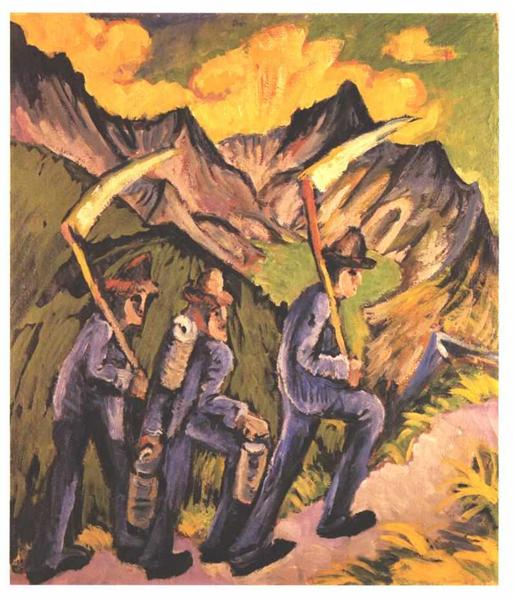Description
Ernst Ludwig Kirchner, central figure of the German expressionist movement and co -founder of the Die Brücke group, displays in his work "Life in the alpine pastures" a vibrant and emotional vision of the mountain landscape that fills both the pictorial space and the mind of the viewer. This painting, created in 1916, is a reflection not only of the distinctive technique of its author, but also of the desire for the connection with nature at a time marked by the turbulence of the First World War.
From a first glance, the work radiates a chromatic intensity that challenges the conventions of the traditional landscape. The saturated green and deep blue dominate, suggestive of pastures and heaven. These colors are not merely descriptive; In the hands of Kirchner, they become instruments of emotion, evoking the purity of mountain air and the serenity that nature can offer in front of human chaos. The bold use of color is characteristic of expressionism, where personal expression and subjective interpretation prevail over reliable representation.
The composition is equally intriguing. In it painting, You can see human figures immersed in a natural landscape. Kirchner presents these characters in a stylized way, with marked lines and constructions that emphasize the tension between man and the environment. The figures seem almost to melt with the landscape, suggesting a symbiosis between the human being and nature. This approach resonated with Die Brücke's philosophy, which promoted a return to essential values and a more authentic life. Through this fusion, Kirchner not only captures the essence of the place, but also transmits a search for significance and spiritual connection.
In addition to its characters and its vibrant color, the work invites a reflection on the mood of the time. Created during World War I, "life in alpine pastures" can be interpreted as a mental refuge against the desolation of urbanism and industrialization that dominated Europe. Here, in this Alpine paradise, the viewer finds an answer to the anxieties of his time: a return to the elementary, to the essential.
The context in which Kirchner produced this work is also essential for his understanding. After moving to Switzerland to escape from the conflict, his work began to reflect not only the peace he found in the alpine landscapes, but also the internal struggles he faced. This is better understood in the framework of its broader work, where the landscape becomes a place of refuge and healing. Among its other landscapes, paintings As "The Green Lake" or "The People of Munich", they also present this connection with geography, but "life in alpine pastures" stands out for their sincere celebration of the human being in their natural habitat.
In short, "Life in the alpine pastures" of Ernst Ludwig Kirchner is not just a representation of a landscape; It is a meditation on the relationship of man with nature and a visual response to the tumult of the modern world. Through its use of color, composition and the subtle integration of human figures in the environment, Kirchner consecrates a place not only on the canvas, but also in the collective memory of expressionist art, marking a legacy that resonates to this day.
KUADROS ©, a famous paint on your wall.
Hand-made oil painting reproductions, with the quality of professional artists and the distinctive seal of KUADROS ©.
Art reproduction service with satisfaction guarantee. If you are not completely satisfied with the replica of your painting, we refund your money 100%.

